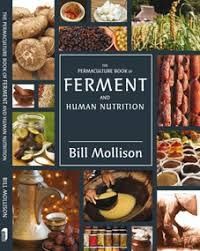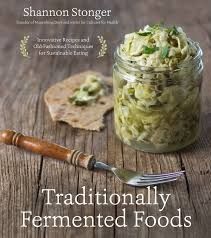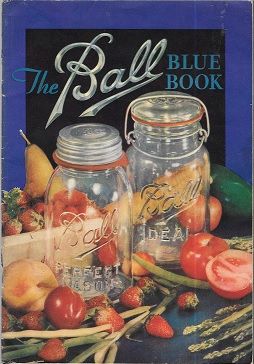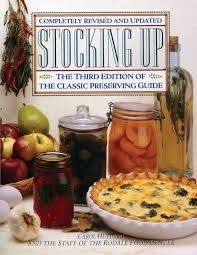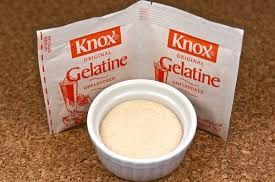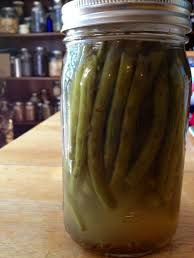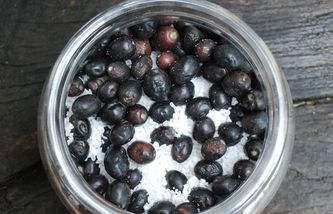THE PERMACULTURE BOOK OF FERMENT AND HUMAN NUTRITION
by Bill Mollison
Bill Mollison is the father of Permaculture, a way to utilize land to its best ability for the production of food for humans and animals. For some of his permaculture books, see "Food Cultivation". His website also offers self-paced online classes through his Permaculture Institute, based in Tasmania, Australia.
In this book, Bill explores worldwide fermentation practices to enhance health, giving us a far wider range of fermentation options:
Chapter 1: Storing--Preserving--Cooking Foods
Chapter 2: The Fungi--Yeasts--Mushrooms--Lichens
Chapter 3: The Grains
Chapter 4: The Legumes
Chapter 5: Roots--Bulbs--Rhizomes
Chapter 6: Fruits--Flowers--Nuts--Oils--Olives
Chapter 7: Leaf--Stem--Aguamiels
Chapter 8: Marine and Freshwater Products--Fish--Molluscs--Algae
Chapter 9: Meats--Birds--Insects
Chapter 10: Dairy Products
Chapter 11: Beers--Wines--Beverages
Chapter 12: Condiments--Spices--Sauces
Chapter 13: Agricultural Composts--Silages--Liquid Manures
Chapter 14: Nutrition and Environmental Health
Traditionally Fermented Foods
by Shannon Stonger
Storage of food should include storage of fermented food or storage of salt and other ingredients to allow you to ferment some of next year's harvest.
Fermentation allows gut health by feeding/building up the good flora in our gut. This is key to health!
Fermentation also allows food to become more nutritious than it is raw!
A good book on fermentation should include many options and great recipes that even kids will love, and this one does:
Chapter 1: The Basic Fermentation Process
Chapter 2: Vegetables
Chapter 3: Grains
Chapter 4: Dairy
Chapter 5: Beverages
Chapter 6: Condiments
Also included: Resources and suggested further reading.
Please note: This lady and her husband are raising a family on a 5-acre farm in Texas, and without electricity! She uses fermentation to help her food last longer!
The Ball Blue Book
If you don't have the Ball Blue Book, you need to get it now. There are canning, freezing & dehydration instructions that will be handy to have on hand even now! Check Amazon. Different years use different photos on covers.
The book is called the Ball Blue Book, but it often is not blue.
Did you know that you can make jams and jellies inside your bread machine?
For storage, you will need to sterilize jars by boiling and then follow canning directions.
Stocking Up
by Carol Hupping
This thick book is full of recipes and is a must-have companion book to the Ball Blue book above. Simon & Schuster Publishers, or check out Amazon online or your favourite book seller.
Cookin' With Home Storage
Gelatine can be used as an egg substitute in your recipes, and so can corn starch:
(To replace each egg: Dissolve 1 tablespoon unflavored gelatin in 1 tablespoon cold water, then add 2 tablespoons boiling water. Beat vigorously until frothy.)
OR cornstarch (Substitute 1 tablespoon cornstarch plus 3 tablespoons water for each egg called for in recipe.
by Peggy Layton
Peggy Layton's Cookin' With Home Storage teaches us how to make meals with basic ingredients from our home food storage supplies. Inspired by the recipes of the American settlers who came out west in their covered wagons, Peggy's book is also a great lesson on how to make substitutions for recipes that you already use and love.
Nourishing Traditions
Lactose-fermentation of veggies, such as these green beans, produces delicious vegetables which also help us to have healthy bowel flora.
This will be especially important if we are eating enzyme-dead canned food for an extended period of time.
You can lactose ferment with sea salt, or with a combination of sea salt and whey.
This book shows you how to make whey too!
Don't be afraid of the cloudiness at the bottom of the jar, that is normal.
Try it now, and see how your digestive tract will love you!
by Sally Fallon
Cream cheese in 8 hours, pickled green beans (yum!) in 3-4 days; why wait? Learn these and other simple skills now and boost your nutrition and the taste value of your food. Sally Fallon'sNourishing Traditions researches the cultures from the past to point out where we have gone terribly wrong. Optimal food combinations in meals is also discussed. And yes, butter is actually GOOD for you!
Preserving Food Without Freezing or Canning
These olives have been preserved in salt.
Mary of Agreda writes in her work, "City of God", that she saw the Blessed Virgin Mary reaching into a wooden barrel filled with salt in order to take olives for the meal she was preparing.
by The Gardeners and Farmers of Terre Vivante
This book comes with tried-and -true testing of traditional techniques. It is a MUST HAVE.
Table of Contents
Chapter 1: Preserving in the Ground or in a Root Cellar
Chapter 2: Preserving by Drying
Chapter 3: Preserving by Lactic Fermentation
Chapter 4: Preserving in Oil
Chapter 5: Preserving in Vinnegar
Chapter 6: Preserving with Salt
Chapter 7: Preserving with Sugar
Chapter 8: Sweet and Sour Preserves
Chapter 9: Preserving in Alcohol
Appendix: Which Method for Preserving Each Food?
